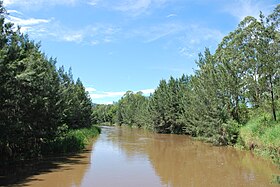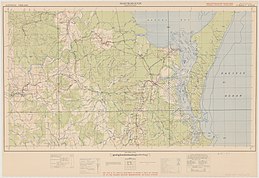geo.wikisort.org - River
The Mary River (Kabi Kabi: Moocooboola) is a major river system located in the South East and Wide Bay–Burnett regions of Queensland, Australia.[1]
| Mary Wide Bay | |
|---|---|
 The upper Mary River at Conondale | |
| Etymology | Lady Mary Lennox,[1] wife of Charles Augustus FitzRoy |
| Native name | Moocooboola (Gabi-Gabi) |
| Location | |
| Country | Australia |
| State | Queensland |
| Regions | South East Queensland, Wide Bay–Burnett |
| Physical characteristics | |
| Source | Conondale Range |
| • location | Conondale, South East Queensland |
| • coordinates | 26°47′39″S 152°44′41″E |
| • elevation | 209 m (686 ft) |
| Mouth | Great Sandy Strait |
• location | River Heads, Wide Bay–Burnett |
• coordinates | 25.4248°S 152.9380°E |
• elevation | 0 m (0 ft) |
| Length | 291 km (181 mi) |
| Basin size | 9,595 km2 (3,705 sq mi) |
| Basin features | |
| Tributaries | |
| • left | Yabba Creek, Kandanga Creek, Widgee Creek, Wide Bay Creek, Munna Creek, Susan River |
| • right | Obi Obi Creek, Tinana Creek, Deep Creek, Six Mile Creek |
| Reservoir | Lake Borumba |
| [2] | |

Etymology
The river was traditionally named Moocooboola by the indigenous Australian Kabi people. The river was named Wide Bay River on 10 May 1842 by early European explorers, Andrew Petrie[3] and Henry Stuart Russell.[4] The official name was changed on 8 September 1847 (prior to Queensland becoming a separate colony) by Charles Augustus FitzRoy, then Governor of New South Wales, to Mary River — after his wife Lady Mary Lennox (15 August 1790 to 7 December 1847).[1]
History
The Mary River was used for rafting timber during the early years of European land settlement, and the discovery of gold at Gympie in 1867 brought an inflow of miners and pastoralists. Alluvial flats along the Mary River and some of its tributaries were used for cropping, and there was small-time dairying in the 1880s.
Course and features



The river rises at Booroobin in the Sunshine Coast hinterland, west of Landsborough. From its source, the Mary River flows north through the towns of Kenilworth, Gympie, Tiaro and Maryborough before emptying into the Great Sandy Strait, a passage of water between the mainland and Fraser Island, near the town of River Heads, 17 km (11 mi) south of the town of Hervey Bay. The Mary River flows into the Great Sandy Strait, near wetlands of international significance recognised by the International agreement of the Ramsar Convention and the UNESCO Fraser Island World Heritage Area, which attracts thousands of visitors every year.
Notable river crossings include the Dickabram Bridge, the Granville Bridge at Maryborough, and the Lamington Bridge.
From source to mouth, the Mary River is joined by nineteen tributaries, including the Tinana Creek, Munna Creek, Obi Obi Creek, Yabba Creek, Wide Bay Creek, Six Mile Creek, Deep Creek, and the Susan River. The river descends 209 metres (686 ft) over its 291-kilometre (181 mi) course.[2] The river's catchment area is 9,595 square kilometres (3,705 sq mi) and is bounded by the Conondale, Jimna and Burnett Ranges.[5]
While there are only two impoundments on the Mary River itself (the Gympie weir, and the barrage at Mungar, south of Tinana) there are a number of dams within the Mary River catchment on tributaries, Borumba Dam on Yabba Creek west of Imbil, Baroon Pocket Dam on Obi Obi Creek west of Montville, Six Mile Creek Dam on Six Mile Creek east of Cooroy, Cedar Pocket Dam on Deep Creek at Cedar Pocket, and two weirs (Talegalla and Teddington) and a barrage on Tinana Creek.
It is also a historical Australian river that contains gold as was first discovered in Gympie by James Nash.
2011 floods
The Mary River experienced major flooding during the 2010–2011 Queensland floods. In some places the river rose 20 metres (66 ft).[6] In Maryborough the river peaked at 8.2 metres (27 ft) while at Gympie the peak was 19.3 metres (63 ft). The Bruce Highway was closed to the north and south of Gympie[7] and more than 50 homes and businesses were inundated.[8] The high turbidity levels interfered with the natural breeding cycle for some of the river species.[6]
Flora and fauna
The endangered Mary River turtle (Elusor macrurus) lives in the river.[9] Other marine life native to the river include the Queensland lungfish (Neoceratodus forsteri) and the endangered Mary River cod (Maccullochella mariensis). Significant vulnerable and endangered species that live in the river also include endangered giant barred frog, Cascade tree frog and Coxen's fig parrot and the vulnerable tusked frog, honey blue-eye fish, the Richmond birdwing butterfly and the Illidge's ant blue butterfly. Saltwater crocodiles are occasionally seen in the lower reaches of the river, with one notable 3.5-metre (11 ft) crocodile being known to live in the river since April 2012.[10] Although the official range for saltwater crocodiles stops near Gladstone, it is widely regarded that the Mary River is the most southerly range limit for crocodiles.
Traveston Crossing Dam
In light of the region's longest drought in one hundred years, the Queensland Government announced on 27 April 2006 its intention to dam part of the Mary River at Traveston Crossing, south of Gympie. The project was cancelled in November 2009, after being refused approval by Federal Environment Minister Peter Garrett.
The action had been planned to create a reservoir "almost as big as the Wivenhoe Dam" by 2011.[11] The Traveston Dam was projected to inundate an area of fertile farmland, endangered regional ecosystems and small towns more than 1.3 times the area of Sydney Harbour.[12] There was considerable local opposition to the proposal, with all Mary Valley and Sunshine Coast Shire Councils opposed to the dam proposal [13] on a variety of grounds including: the dislocation of the local community from the inundated area; adverse effects on downstream communities; and environmental impacts such as the removal of one of the few remaining habitats for the vulnerable Queensland Lungfish.[14] More than 20,000 residents formally petitioned the Queensland State Parliament to halt the dam. There were further concerns that the geomechanics of the proposed site were not suitable for damming due to potentially significant leakage (due to the predominantly sandy substrate) and evaporation problems.[15]
There was strong opposition to the dam from the wider and international community, based on environmental concerns related to the endangered Mary River cod, Mary River turtle, giant barred frog, Cascade tree frog, Coxen's fig parrot, the vulnerable Queensland lungfish, tusked frog, honey blue-eye fish, the Richmond birdwing butterfly and the Illidge's ant blue butterfly.[16] There were also fears for the dugong, a globally vulnerable species. It was alleged that reduced fresh water flowing to the Great Sandy Strait would have affected the growth of seagrass, the dugong's primary food source.
The Mary River Turtle and the Queensland Lungfish attracted particular attention regarding their conservation. The Mary River Turtle, whose only known home is the Mary River, is a cloacal ventilator ('bum breather' – it uses oxygen from water taken in through its tail), and is listed in the top 25 most endangered turtle species in the world. The Lungfish also has great significance to evolutionary biologists. It requires the rapids in order to breed, and much of its breeding habitat had already been interrupted by other dams in Queensland. Professor Jean Joss of Macquarie University stated, in a submission to the Senate Inquiry 2007: "The Mary River dam would almost certainly push the lungfish to 'Critically Endangered,' and in the long term will lead to its extinction in the wild."[citation needed] The Mary River Cod, which only lives naturally in the Mary River system, is already Critically Endangered. It is completely protected, and it is illegal to fish them.

Port of Maryborough
The Port of Maryborough was opened in 1847 and in 1859 it was declared a port of entry. In 1856, after the river became unnavigable to larger vessels a new township and port were established. From the 1850s to the end of the century the port was one of Australia's busiest immigration ports.[17] Some authorities called the port "Wide Bay" well into the 1860s.
See also
- List of rivers of Queensland
References
- "Mary River (entry 21155)". Queensland Place Names. Queensland Government. Retrieved 28 August 2015.
- "Map of Mary River, QLD". Bonzle Digital Atlas of Australia. Archived from the original on 29 August 2016. Retrieved 14 November 2015.
- Petrie, Constance Campbell (1904). "Part II Chapter VI". Tom Petrie's Reminiscences of Early Queensland. Brisbane: Watson, Ferguson & Co. p. 261. Archived from the original on 11 January 2014. Retrieved 19 October 2012.
- Russell, Henry Stuart (1888). The Genesis of Queensland. Sydney: Turner & Henderson. pp. 272. Archived from the original on 26 August 2016. Retrieved 18 August 2016.
- "Water resources – Overview – Queensland – Basin & Surface Water Management Area: Mary River (Qld)". Australian Natural Resources Atlas. Department of the Environment, Water, Heritage and the Arts. Archived from the original on 4 October 2009. Retrieved 25 May 2009.
- Volkofsky, Aimee (26 January 2011). "Mary River battered by flood waters". ABC News. Wide Bay, Australia. Archived from the original on 12 November 2012. Retrieved 31 January 2011.
- "Mary River floodwaters fill Gympie streets". ABC News. Australia. 11 January 2011. Archived from the original on 11 February 2011. Retrieved 31 January 2011.
- Cubby, Ben (12 January 2011). "Peak leaves city severed and submerged". The Sydney Morning Herald. Archived from the original on 7 November 2012. Retrieved 31 January 2011.
- "Mary River turtle". Queensland's Vanishing Wildlife. Archived from the original on 11 May 2006. Retrieved 18 April 2006.
- "'Extreme caution' urged over elusive Mary River croc". ABC News. Australia. 10 May 2013. Archived from the original on 25 March 2013. Retrieved 10 May 2010.
- "Qld Govt proposes Mary River dam". ABC News. Australia. 27 April 2006. Archived from the original on 24 February 2014. Retrieved 27 April 2006.
- "Bishop to visit mega dam site". Archived from the original on 29 September 2007. Retrieved 14 August 2006.
- "Mayors unite to block dam, find own solution". Gympie Times. 12 August 2006. Retrieved 31 October 2006.
- "Cooloola Shire Council Meeting Minutes" (PDF). Retrieved 31 October 2006.[permanent dead link]
- "Expert raises Mary River dam leakage fears". ABC News. Australia. 14 June 2006. Archived from the original on 24 February 2014. Retrieved 25 June 2006.
- "Report to Garrett says dam species will die". Brisbane Times. 28 November 2008. Archived from the original on 25 September 2012. Retrieved 5 December 2008.
- "Harbour facilities". Fraser Coast Regional Council. Archived from the original on 14 February 2015. Retrieved 7 November 2012.
External links
- Aerial video of the Mary River Valley and Kenilworth
- Mary River Catchment Coordinating Committee
- Help Save the Australian Lungfish
На других языках
[de] Mary River (Korallenmeer)
Der Mary River ist ein Fluss im Südosten des australischen Bundesstaates Queensland.- [en] Mary River (Queensland)
[es] Río Mary
El río Mary es un sistema de ríos grandes en el sudeste de Queensland, Australia . El río nace en Booroobin en la Sunshine Coast hinterland, al oeste de Landsborough. Desde su nacimiento, el río Mary fluye hacia el norte a través de las localidades de Kenilworth, Gympie, Maryborough y Tiaro, antes de desembocar en el Gran Estrecho de arena, un paso de agua entre el continente y la isla de Fraser, cerca del pueblo de River Heads, 17 km ( 11 millas ) al sur de Hervey Bay.[ru] Мэри (река)
Мэри (англ. Mary River) — река в регионе Саншайн-Кост, штат Квинсленд, Австралия.Другой контент может иметь иную лицензию. Перед использованием материалов сайта WikiSort.org внимательно изучите правила лицензирования конкретных элементов наполнения сайта.
WikiSort.org - проект по пересортировке и дополнению контента Википедии
